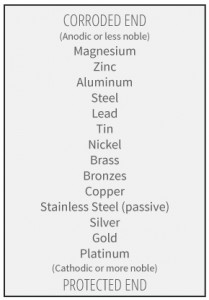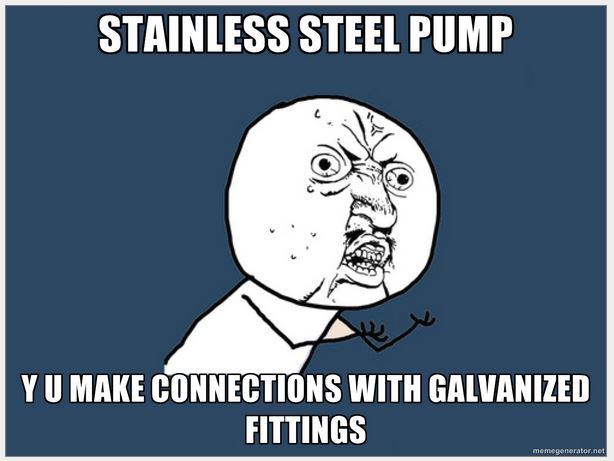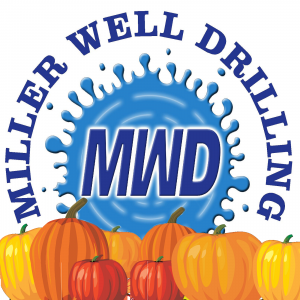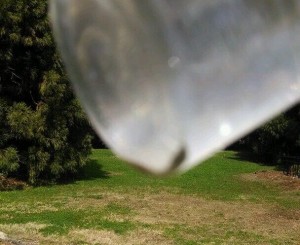Corrosion on dissimilar metals is often called “electrolysis”, but it is technically not. Without splitting hairs, we’ll discuss the actual problem, why it is important to well owners, and how a quality water system can be built to avoid it.
In iron wells, or in wells that have pH or TDS issues, the water can become very aggressive to metals, especially steel and iron. This can be further exacerbated when dissimilar metals are connected. In the above example, the iron in the water was attacking the Galvanized Steel Pipe, and was doing the most damage where the installer had used brass check valves. The brass was literally pulling galvanization from the steel, accelerating the damage to the steel the closer it got to the brass.

This not only compounds the water problems- putting more iron into the well- it also leads to early equipment failure. That pipe was 6-years old and already had holes in it around these connections. It actually broke as we were pulling the pump, and the pipe elevator and quick thinking by the technician was the only thing that kept us from losing the pump and the remaining pipe down the hole.
Galvanic Corrosion is an electrochemical process in which one metal corrodes preferentially to another when both metals are in electrical contact, in the presence of an electrolyte. This same galvanic reaction is exploited in primary batteries to generate an electrical voltage.
The less “Noble” the metal, the more likely it is to corrode when it comes in contact with electrolytes in the water. The most active (Anodic) of these is magnesium and zinc and the most Noble (Cathodic) is platinum and graphite. The metals that are commonly used in plumbing and electrical wiring fall somewhere in the spectrum between the two.

Well drop pipe and fittings are usually made from PVC, copper, brass, or galvanized pipe. That plumbing is built for neutral water, though; and raw groundwater is often anything but neutral.
Even though they know that it won’t last in water wells, many well drillers install galvanized pipe because it has a high tensile strength, relative to the cost of the material. It is an added insurance against an installer over-tightening fittings, and also keeping the equipment from wrenching itself apart in normal operation. This is especially important when a large pump is installed in a deep well, as the torque from starting and stopping, as well as the weight of the assembly, but all of these issues can be overcome with careful installation of Schedule 120 PVC pipe and using plenty of torque arrestors to help support the drop assembly inside the well, and a single stick of stainless pipe at the bottom to help absorb the torque from the pump.
Since PVC is non-corrosive, the brass check valves along the way won’t affect them, and wherever another metal has to be used- at the well head, for example, where brass or copper fittings are often installed- stainless is used wherever practical. Most Well Drilling Supply houses stock an extensive selection of stainless fittings up to 2″. All this extra care and “Noble” metal is a bit more expensive, but worth it for the water quality and well and equipment stability it helps ensure.
We don’t even stock galvanized fittings anymore. Stainless Steel is just one of the components that makes a Certified Water System qualify for a Lifetime Parts and Labor Warranty.

![IMG_20140909_141232310[1]](http://www.millerwelldrilling.com/wp-content/uploads/2014/09/IMG_20140909_1412323101-1024x576.jpg)


Hi Rob, I ran across your page (and appreciate this!) looking for a third party’s explanation to share with the public of what well materials to watch out for. I work in a county health department in the Well Permitting program and we are seeing lead in drinking water samples. The metals used to construct the drop pipe (okay, and everywhere between the pump and the tap) seem to be the culprit. Of course, there are scads of water samples that show no detectable lead, and there is also metal in the mix. Maybe, as you suggest, a combination of metals is the deadly cocktail. I’d like to be able to share information directly with homeowners before their wells are drilled, but it has proved difficult finding a tactful way to say “watch out for this!… even though we don’t completely understand it.” Would you be willing to share more information with me on your experience in this field? I’m trying to buff up on it so I can share the right information with the public. Kind regards.